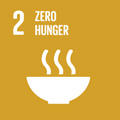- Docente: Sara Bosi
- Credits: 6
- SSD: AGR/02
- Language: Italian
-
from Feb 26, 2025 to Mar 27, 2025
-
from Apr 02, 2025 to May 23, 2025
Learning outcomes
At the end of the course, the student possesses the knowledge on food crops in the appropriate productive and geographical context. He knows the main herbaceous food crops, with particular regard to the qualitative and technological characteristics and the factors affecting them.
Course contents
The course of Ecology of vegetable production and herbaceous crops represents one of the modules of the integrated course of Vegetable production. The course is made up of two parts: the first, "Ecology of vegetable production" is preparatory to both the second part and the "fruit science" module. This part provides elements of: plant morphology and crop ecology, with particular
Introduction and hints on systematics and botanical nomenclature
Cereals. General traits and systematics. Graminaceae: general characteristics, inflorescence morphology. Morphology and composition of the kernel. Cool and warm season cereals.
Wheats. Genus Triticum: evolution and cultivated forms. The cycle, kernels growth. Bread and durum wheat: quality characteristics; commercial quality; milling quality, proteins; amylasic activity; gluten content and quality, technological quality; Chopin alveogram, farinogram. Durum wheat quality. Hints on cropping techniques.
Barley. Feed an malt barley; quality traits for malt production.
Other winter cereals: oats, rye, minor wheats. Pseudocereals: buckwheat.
Rice. traits, quality characteristics; hints on first processing; hints on cropping techniques.
Corn. traits and uses. Humid and dry milling, products and related quality characteristics; elements of cropping techniques.
Oilseed crops. general traits. Processing and main quality traits. Main quality and yield characteristics of soybeans, sunflower, rapeseed. Hints on other oilseed crops.
Food legumes. General traits and quality characteristics. Direct food uses and industrial processing. Main quality traits and production of peas and common beans. Hints on horse beans, lentil, chickpeas, cowpeas.
Sugar crops. Sugar beet: quality and yield characters. Hints on sugar cane.
Potato: composition, quality traits, post harvest physiology; uses and types; growing cycle.
Vegetables for direct consumption or processing. Tomato. Composition and quality traits, with special respect for processing tomato. Cycle and production.
Cucurbitaceae. General traits; vegetable and industry cucumber; hints on melon, watermelon, squashes.
Asteraceae. Artichoke: quality, uses and cycle. Chicories: types, uses; lettuces.
Alliaceae: onion and other species.
Daucaceae: carrot and other species.
Aspects of herbs, spices and dye plants.
Practical (second semester)
Acquisition of knowledge and manual skills for the basic qualitative determination of cereals, with particular regard to wheat and fruit and vegetable species
Readings/Bibliography
Some reference textbooks swill be indicated during the course. However, the students are advised to use the given material and lecture content
Teaching methods
Frontal lessons
The lectures are held in the classroom, at planned times, assisted by the projection of didactic material. The standard lesson time lasts 45 minutes.
Practical lessons
The practical lessons consist of: laboratory exercises and / or guided tours in farms (according to the availability of the farms).
Assessment methods
The course is organized in two modules. Therefore, the evaluation of the course takes into account jointly the level of knowledge and skills acquired by the student in relation to the contents of both modules.
The assessment of learning takes place only through the final examination, which is aimed to verify the acquisition of expected knowledge and skills by an oral exam.
Teaching tools
The material presented during the lessons (powerpoint slides) is available to students on the VIRTUALE teaching platform.
Cesena and Bologna didactic laboratory.
Office hours
See the website of Sara Bosi
SDGs


This teaching activity contributes to the achievement of the Sustainable Development Goals of the UN 2030 Agenda.
